Accounting and Financial Reporting: A Deep Dive into Finance Leases
VerifiedAdded on 2023/04/20
|6
|1409
|390
Essay
AI Summary
This essay provides an in-depth analysis of accounting and financial reporting for finance leases from the perspective of the lessee, focusing on the requirements outlined in AASB 16. It covers the recognition, measurement, and presentation of right-to-use assets and lease liabilities, including the initial evaluation at lease inception and subsequent accounting treatments. The essay details how lease payments, including fixed payments, variable payments, and residual value guarantees, are considered in determining the lease liability. It further explains the impact of finance leases on the balance sheet, income statement, and cash flow statement, emphasizing the reporting of lease assets, liabilities, interest expenses, and principal repayments. The importance of disclosures, both quantitative and qualitative, regarding lease activities and significant judgments is also highlighted, referencing relevant accounting standards and research.
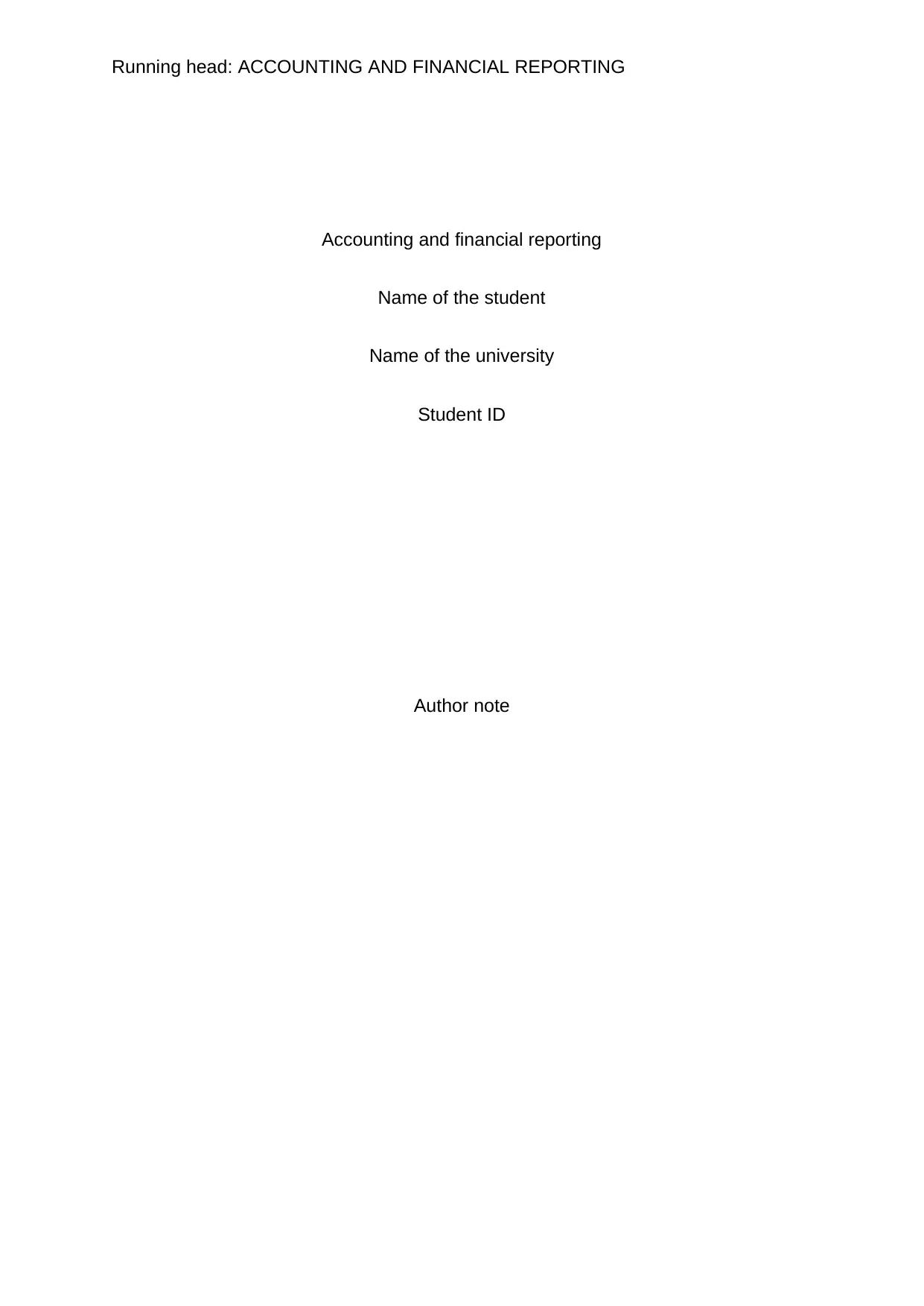
Running head: ACCOUNTING AND FINANCIAL REPORTING
Accounting and financial reporting
Name of the student
Name of the university
Student ID
Author note
Accounting and financial reporting
Name of the student
Name of the university
Student ID
Author note
Paraphrase This Document
Need a fresh take? Get an instant paraphrase of this document with our AI Paraphraser
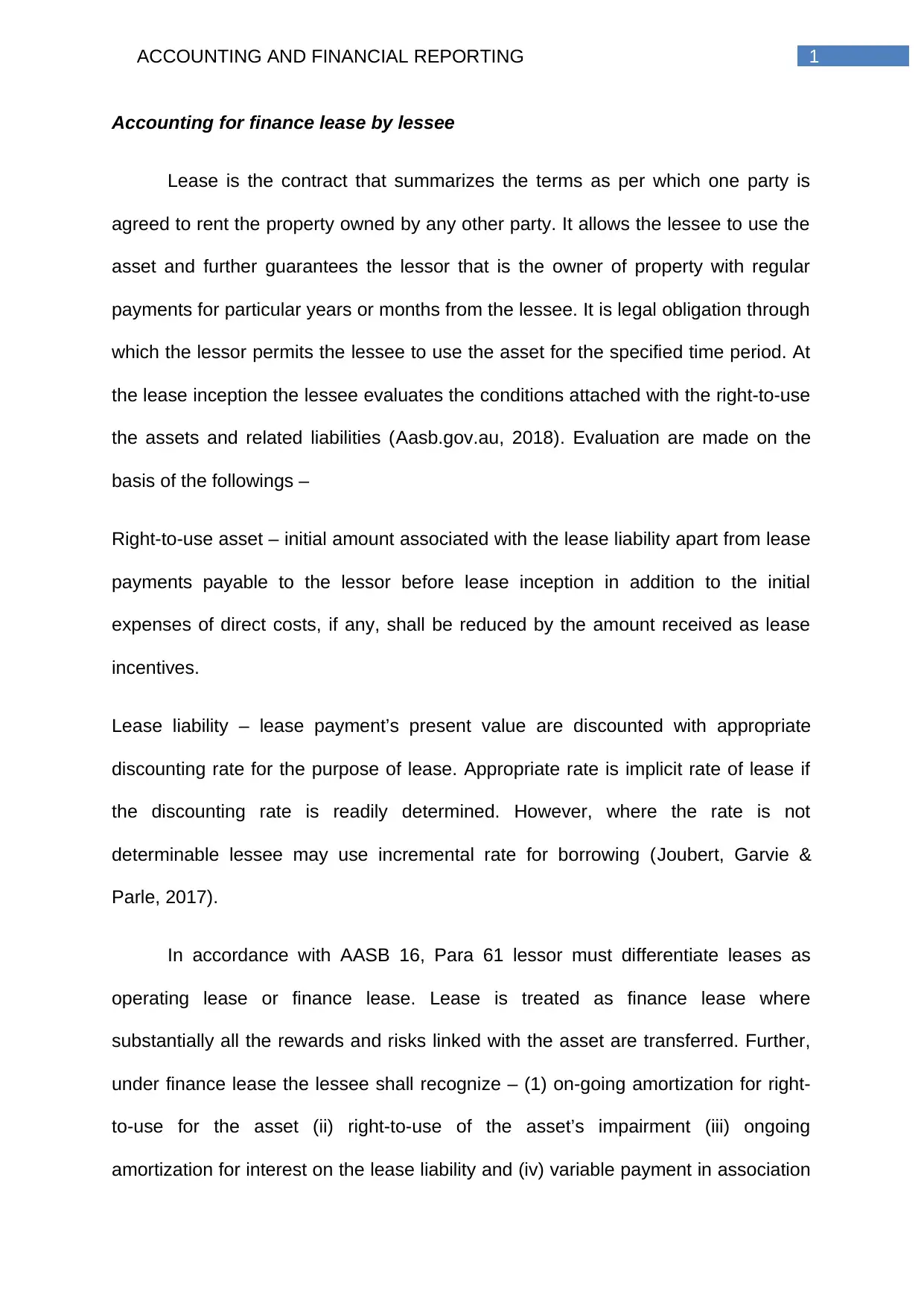
1ACCOUNTING AND FINANCIAL REPORTING
Accounting for finance lease by lessee
Lease is the contract that summarizes the terms as per which one party is
agreed to rent the property owned by any other party. It allows the lessee to use the
asset and further guarantees the lessor that is the owner of property with regular
payments for particular years or months from the lessee. It is legal obligation through
which the lessor permits the lessee to use the asset for the specified time period. At
the lease inception the lessee evaluates the conditions attached with the right-to-use
the assets and related liabilities (Aasb.gov.au, 2018). Evaluation are made on the
basis of the followings –
Right-to-use asset – initial amount associated with the lease liability apart from lease
payments payable to the lessor before lease inception in addition to the initial
expenses of direct costs, if any, shall be reduced by the amount received as lease
incentives.
Lease liability – lease payment’s present value are discounted with appropriate
discounting rate for the purpose of lease. Appropriate rate is implicit rate of lease if
the discounting rate is readily determined. However, where the rate is not
determinable lessee may use incremental rate for borrowing (Joubert, Garvie &
Parle, 2017).
In accordance with AASB 16, Para 61 lessor must differentiate leases as
operating lease or finance lease. Lease is treated as finance lease where
substantially all the rewards and risks linked with the asset are transferred. Further,
under finance lease the lessee shall recognize – (1) on-going amortization for right-
to-use for the asset (ii) right-to-use of the asset’s impairment (iii) ongoing
amortization for interest on the lease liability and (iv) variable payment in association
Accounting for finance lease by lessee
Lease is the contract that summarizes the terms as per which one party is
agreed to rent the property owned by any other party. It allows the lessee to use the
asset and further guarantees the lessor that is the owner of property with regular
payments for particular years or months from the lessee. It is legal obligation through
which the lessor permits the lessee to use the asset for the specified time period. At
the lease inception the lessee evaluates the conditions attached with the right-to-use
the assets and related liabilities (Aasb.gov.au, 2018). Evaluation are made on the
basis of the followings –
Right-to-use asset – initial amount associated with the lease liability apart from lease
payments payable to the lessor before lease inception in addition to the initial
expenses of direct costs, if any, shall be reduced by the amount received as lease
incentives.
Lease liability – lease payment’s present value are discounted with appropriate
discounting rate for the purpose of lease. Appropriate rate is implicit rate of lease if
the discounting rate is readily determined. However, where the rate is not
determinable lessee may use incremental rate for borrowing (Joubert, Garvie &
Parle, 2017).
In accordance with AASB 16, Para 61 lessor must differentiate leases as
operating lease or finance lease. Lease is treated as finance lease where
substantially all the rewards and risks linked with the asset are transferred. Further,
under finance lease the lessee shall recognize – (1) on-going amortization for right-
to-use for the asset (ii) right-to-use of the asset’s impairment (iii) ongoing
amortization for interest on the lease liability and (iv) variable payment in association
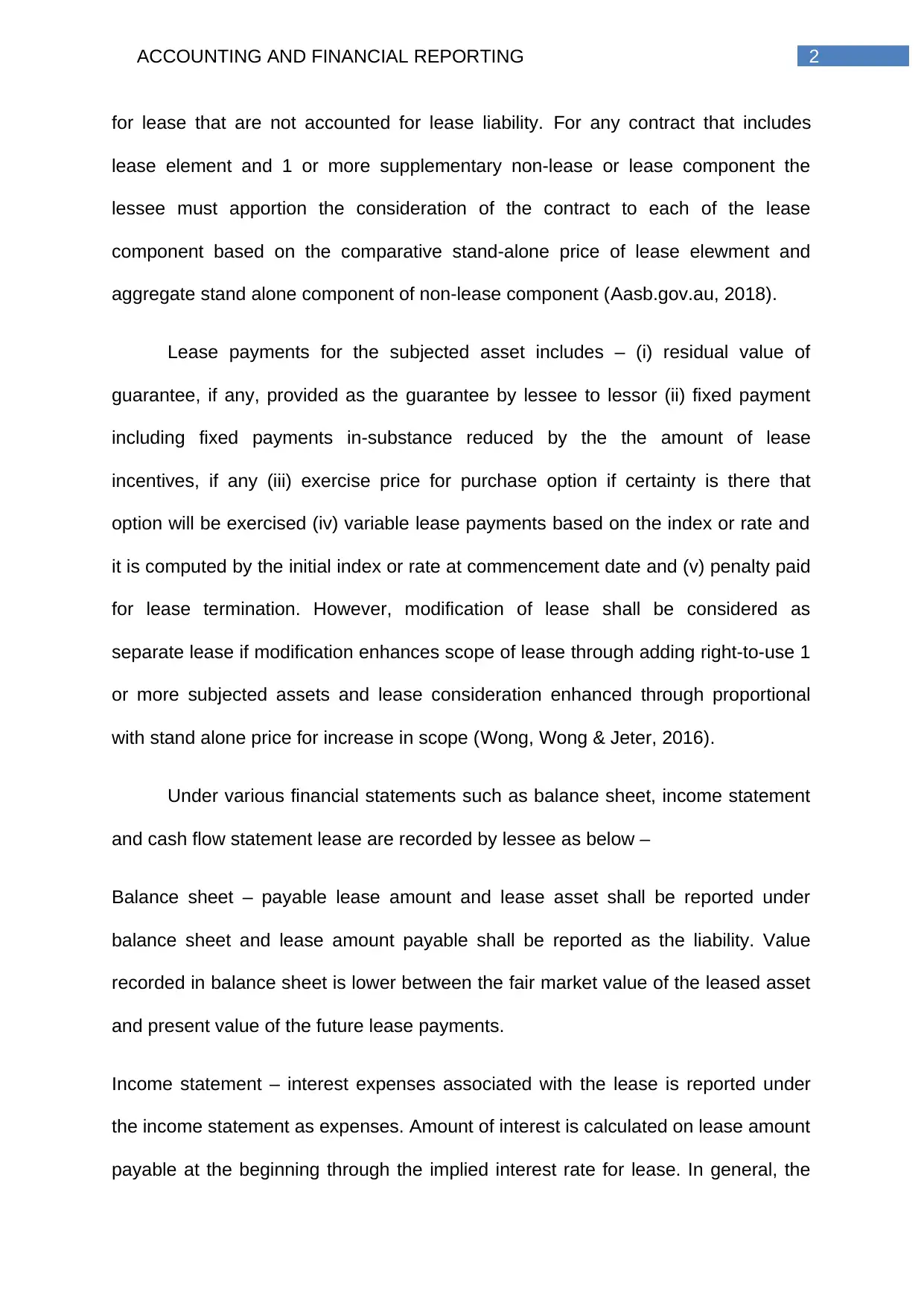
2ACCOUNTING AND FINANCIAL REPORTING
for lease that are not accounted for lease liability. For any contract that includes
lease element and 1 or more supplementary non-lease or lease component the
lessee must apportion the consideration of the contract to each of the lease
component based on the comparative stand-alone price of lease elewment and
aggregate stand alone component of non-lease component (Aasb.gov.au, 2018).
Lease payments for the subjected asset includes – (i) residual value of
guarantee, if any, provided as the guarantee by lessee to lessor (ii) fixed payment
including fixed payments in-substance reduced by the the amount of lease
incentives, if any (iii) exercise price for purchase option if certainty is there that
option will be exercised (iv) variable lease payments based on the index or rate and
it is computed by the initial index or rate at commencement date and (v) penalty paid
for lease termination. However, modification of lease shall be considered as
separate lease if modification enhances scope of lease through adding right-to-use 1
or more subjected assets and lease consideration enhanced through proportional
with stand alone price for increase in scope (Wong, Wong & Jeter, 2016).
Under various financial statements such as balance sheet, income statement
and cash flow statement lease are recorded by lessee as below –
Balance sheet – payable lease amount and lease asset shall be reported under
balance sheet and lease amount payable shall be reported as the liability. Value
recorded in balance sheet is lower between the fair market value of the leased asset
and present value of the future lease payments.
Income statement – interest expenses associated with the lease is reported under
the income statement as expenses. Amount of interest is calculated on lease amount
payable at the beginning through the implied interest rate for lease. In general, the
for lease that are not accounted for lease liability. For any contract that includes
lease element and 1 or more supplementary non-lease or lease component the
lessee must apportion the consideration of the contract to each of the lease
component based on the comparative stand-alone price of lease elewment and
aggregate stand alone component of non-lease component (Aasb.gov.au, 2018).
Lease payments for the subjected asset includes – (i) residual value of
guarantee, if any, provided as the guarantee by lessee to lessor (ii) fixed payment
including fixed payments in-substance reduced by the the amount of lease
incentives, if any (iii) exercise price for purchase option if certainty is there that
option will be exercised (iv) variable lease payments based on the index or rate and
it is computed by the initial index or rate at commencement date and (v) penalty paid
for lease termination. However, modification of lease shall be considered as
separate lease if modification enhances scope of lease through adding right-to-use 1
or more subjected assets and lease consideration enhanced through proportional
with stand alone price for increase in scope (Wong, Wong & Jeter, 2016).
Under various financial statements such as balance sheet, income statement
and cash flow statement lease are recorded by lessee as below –
Balance sheet – payable lease amount and lease asset shall be reported under
balance sheet and lease amount payable shall be reported as the liability. Value
recorded in balance sheet is lower between the fair market value of the leased asset
and present value of the future lease payments.
Income statement – interest expenses associated with the lease is reported under
the income statement as expenses. Amount of interest is calculated on lease amount
payable at the beginning through the implied interest rate for lease. In general, the
⊘ This is a preview!⊘
Do you want full access?
Subscribe today to unlock all pages.

Trusted by 1+ million students worldwide
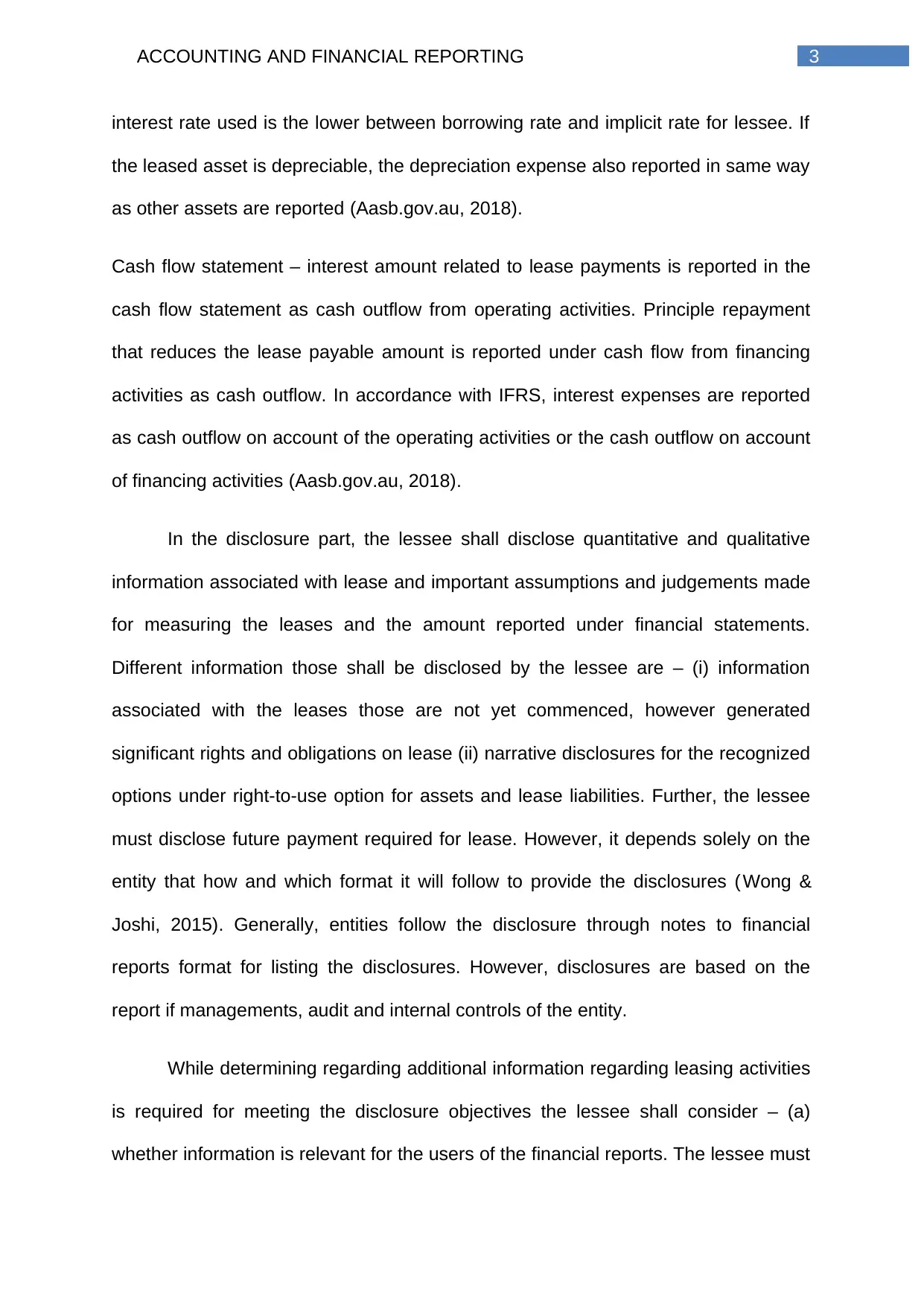
3ACCOUNTING AND FINANCIAL REPORTING
interest rate used is the lower between borrowing rate and implicit rate for lessee. If
the leased asset is depreciable, the depreciation expense also reported in same way
as other assets are reported (Aasb.gov.au, 2018).
Cash flow statement – interest amount related to lease payments is reported in the
cash flow statement as cash outflow from operating activities. Principle repayment
that reduces the lease payable amount is reported under cash flow from financing
activities as cash outflow. In accordance with IFRS, interest expenses are reported
as cash outflow on account of the operating activities or the cash outflow on account
of financing activities (Aasb.gov.au, 2018).
In the disclosure part, the lessee shall disclose quantitative and qualitative
information associated with lease and important assumptions and judgements made
for measuring the leases and the amount reported under financial statements.
Different information those shall be disclosed by the lessee are – (i) information
associated with the leases those are not yet commenced, however generated
significant rights and obligations on lease (ii) narrative disclosures for the recognized
options under right-to-use option for assets and lease liabilities. Further, the lessee
must disclose future payment required for lease. However, it depends solely on the
entity that how and which format it will follow to provide the disclosures ( Wong &
Joshi, 2015). Generally, entities follow the disclosure through notes to financial
reports format for listing the disclosures. However, disclosures are based on the
report if managements, audit and internal controls of the entity.
While determining regarding additional information regarding leasing activities
is required for meeting the disclosure objectives the lessee shall consider – (a)
whether information is relevant for the users of the financial reports. The lessee must
interest rate used is the lower between borrowing rate and implicit rate for lessee. If
the leased asset is depreciable, the depreciation expense also reported in same way
as other assets are reported (Aasb.gov.au, 2018).
Cash flow statement – interest amount related to lease payments is reported in the
cash flow statement as cash outflow from operating activities. Principle repayment
that reduces the lease payable amount is reported under cash flow from financing
activities as cash outflow. In accordance with IFRS, interest expenses are reported
as cash outflow on account of the operating activities or the cash outflow on account
of financing activities (Aasb.gov.au, 2018).
In the disclosure part, the lessee shall disclose quantitative and qualitative
information associated with lease and important assumptions and judgements made
for measuring the leases and the amount reported under financial statements.
Different information those shall be disclosed by the lessee are – (i) information
associated with the leases those are not yet commenced, however generated
significant rights and obligations on lease (ii) narrative disclosures for the recognized
options under right-to-use option for assets and lease liabilities. Further, the lessee
must disclose future payment required for lease. However, it depends solely on the
entity that how and which format it will follow to provide the disclosures ( Wong &
Joshi, 2015). Generally, entities follow the disclosure through notes to financial
reports format for listing the disclosures. However, disclosures are based on the
report if managements, audit and internal controls of the entity.
While determining regarding additional information regarding leasing activities
is required for meeting the disclosure objectives the lessee shall consider – (a)
whether information is relevant for the users of the financial reports. The lessee must
Paraphrase This Document
Need a fresh take? Get an instant paraphrase of this document with our AI Paraphraser
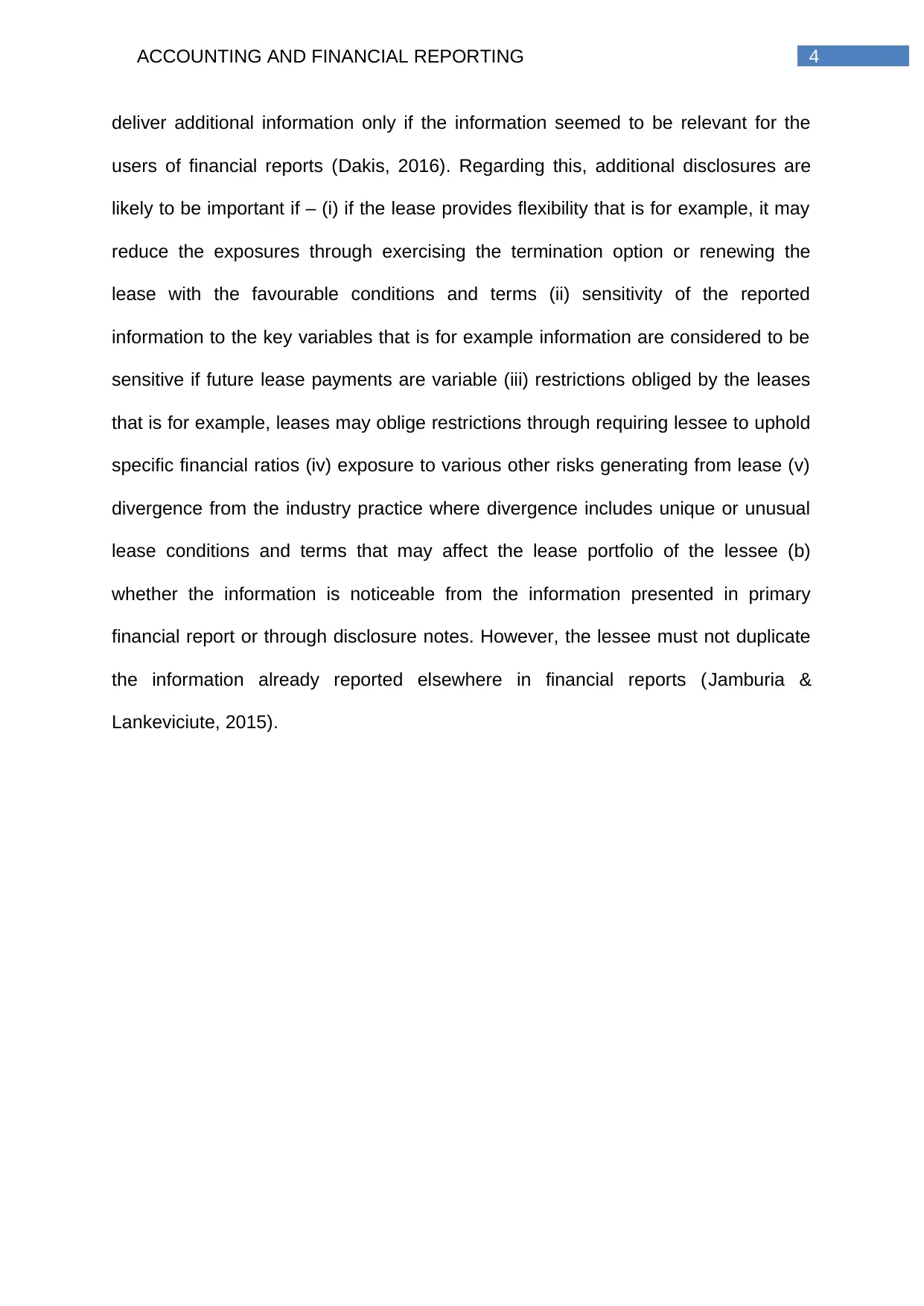
4ACCOUNTING AND FINANCIAL REPORTING
deliver additional information only if the information seemed to be relevant for the
users of financial reports (Dakis, 2016). Regarding this, additional disclosures are
likely to be important if – (i) if the lease provides flexibility that is for example, it may
reduce the exposures through exercising the termination option or renewing the
lease with the favourable conditions and terms (ii) sensitivity of the reported
information to the key variables that is for example information are considered to be
sensitive if future lease payments are variable (iii) restrictions obliged by the leases
that is for example, leases may oblige restrictions through requiring lessee to uphold
specific financial ratios (iv) exposure to various other risks generating from lease (v)
divergence from the industry practice where divergence includes unique or unusual
lease conditions and terms that may affect the lease portfolio of the lessee (b)
whether the information is noticeable from the information presented in primary
financial report or through disclosure notes. However, the lessee must not duplicate
the information already reported elsewhere in financial reports (Jamburia &
Lankeviciute, 2015).
deliver additional information only if the information seemed to be relevant for the
users of financial reports (Dakis, 2016). Regarding this, additional disclosures are
likely to be important if – (i) if the lease provides flexibility that is for example, it may
reduce the exposures through exercising the termination option or renewing the
lease with the favourable conditions and terms (ii) sensitivity of the reported
information to the key variables that is for example information are considered to be
sensitive if future lease payments are variable (iii) restrictions obliged by the leases
that is for example, leases may oblige restrictions through requiring lessee to uphold
specific financial ratios (iv) exposure to various other risks generating from lease (v)
divergence from the industry practice where divergence includes unique or unusual
lease conditions and terms that may affect the lease portfolio of the lessee (b)
whether the information is noticeable from the information presented in primary
financial report or through disclosure notes. However, the lessee must not duplicate
the information already reported elsewhere in financial reports (Jamburia &
Lankeviciute, 2015).
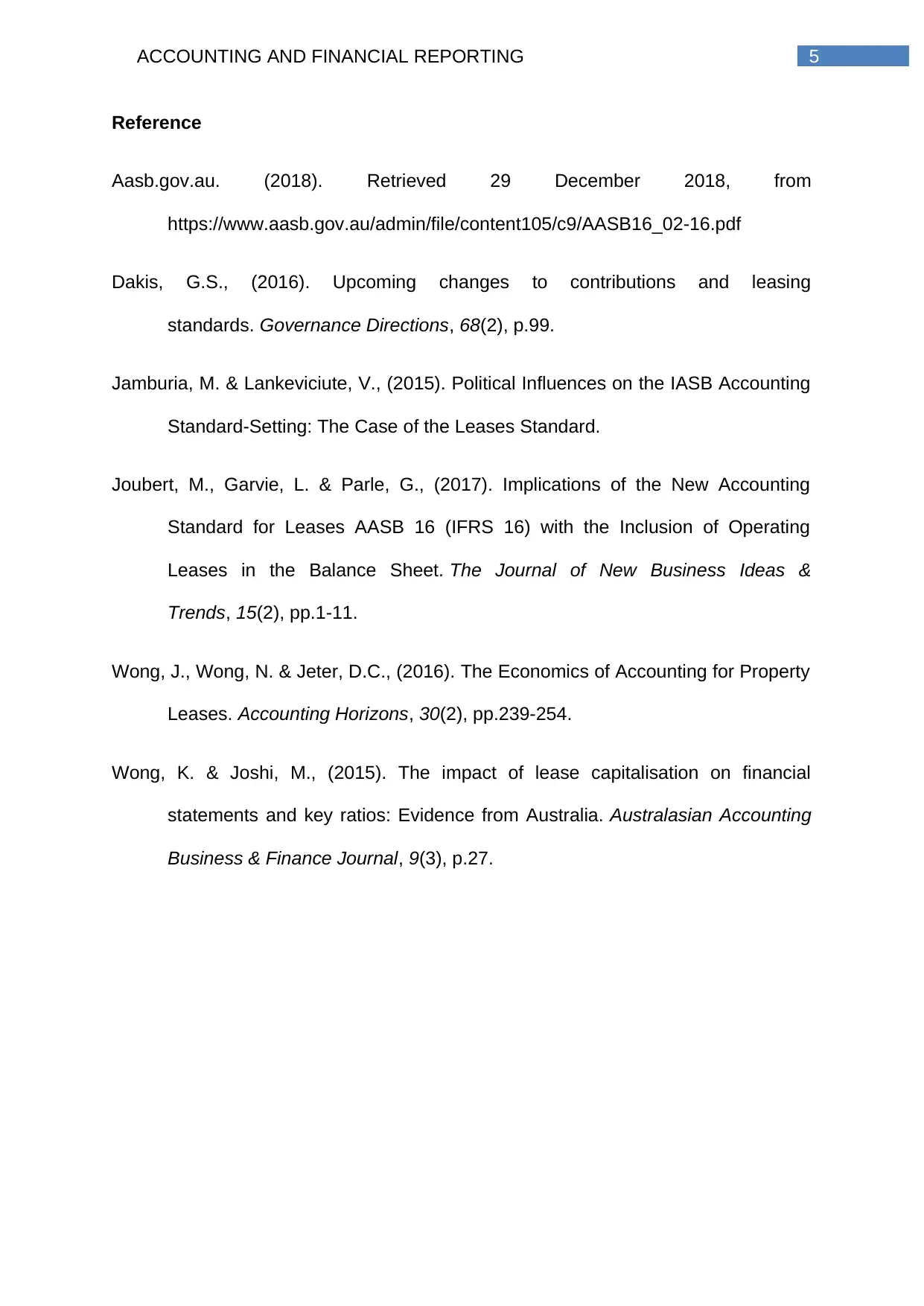
5ACCOUNTING AND FINANCIAL REPORTING
Reference
Aasb.gov.au. (2018). Retrieved 29 December 2018, from
https://www.aasb.gov.au/admin/file/content105/c9/AASB16_02-16.pdf
Dakis, G.S., (2016). Upcoming changes to contributions and leasing
standards. Governance Directions, 68(2), p.99.
Jamburia, M. & Lankeviciute, V., (2015). Political Influences on the IASB Accounting
Standard-Setting: The Case of the Leases Standard.
Joubert, M., Garvie, L. & Parle, G., (2017). Implications of the New Accounting
Standard for Leases AASB 16 (IFRS 16) with the Inclusion of Operating
Leases in the Balance Sheet. The Journal of New Business Ideas &
Trends, 15(2), pp.1-11.
Wong, J., Wong, N. & Jeter, D.C., (2016). The Economics of Accounting for Property
Leases. Accounting Horizons, 30(2), pp.239-254.
Wong, K. & Joshi, M., (2015). The impact of lease capitalisation on financial
statements and key ratios: Evidence from Australia. Australasian Accounting
Business & Finance Journal, 9(3), p.27.
Reference
Aasb.gov.au. (2018). Retrieved 29 December 2018, from
https://www.aasb.gov.au/admin/file/content105/c9/AASB16_02-16.pdf
Dakis, G.S., (2016). Upcoming changes to contributions and leasing
standards. Governance Directions, 68(2), p.99.
Jamburia, M. & Lankeviciute, V., (2015). Political Influences on the IASB Accounting
Standard-Setting: The Case of the Leases Standard.
Joubert, M., Garvie, L. & Parle, G., (2017). Implications of the New Accounting
Standard for Leases AASB 16 (IFRS 16) with the Inclusion of Operating
Leases in the Balance Sheet. The Journal of New Business Ideas &
Trends, 15(2), pp.1-11.
Wong, J., Wong, N. & Jeter, D.C., (2016). The Economics of Accounting for Property
Leases. Accounting Horizons, 30(2), pp.239-254.
Wong, K. & Joshi, M., (2015). The impact of lease capitalisation on financial
statements and key ratios: Evidence from Australia. Australasian Accounting
Business & Finance Journal, 9(3), p.27.
⊘ This is a preview!⊘
Do you want full access?
Subscribe today to unlock all pages.

Trusted by 1+ million students worldwide
1 out of 6
Related Documents
Your All-in-One AI-Powered Toolkit for Academic Success.
+13062052269
info@desklib.com
Available 24*7 on WhatsApp / Email
![[object Object]](/_next/static/media/star-bottom.7253800d.svg)
Unlock your academic potential
Copyright © 2020–2025 A2Z Services. All Rights Reserved. Developed and managed by ZUCOL.




